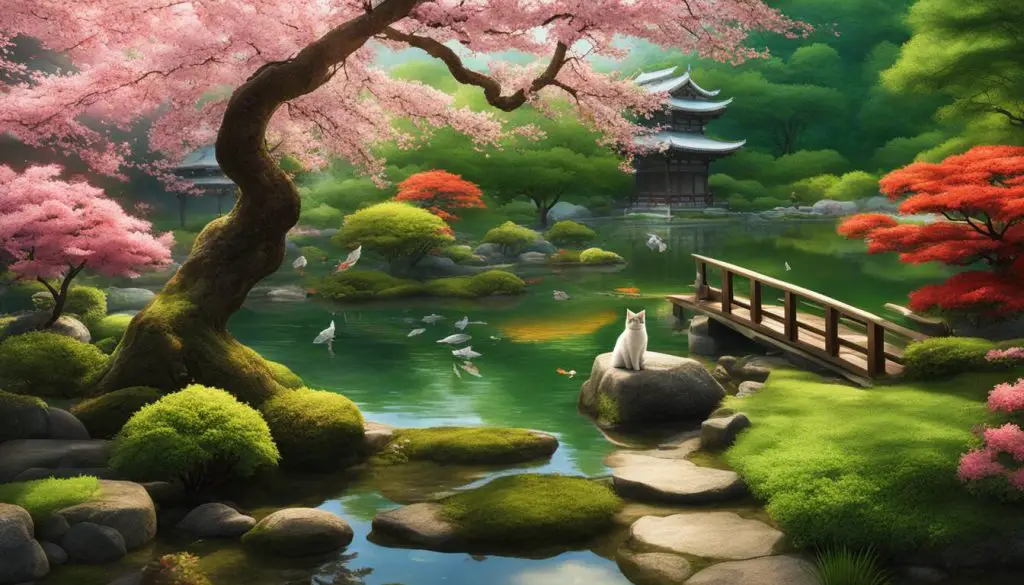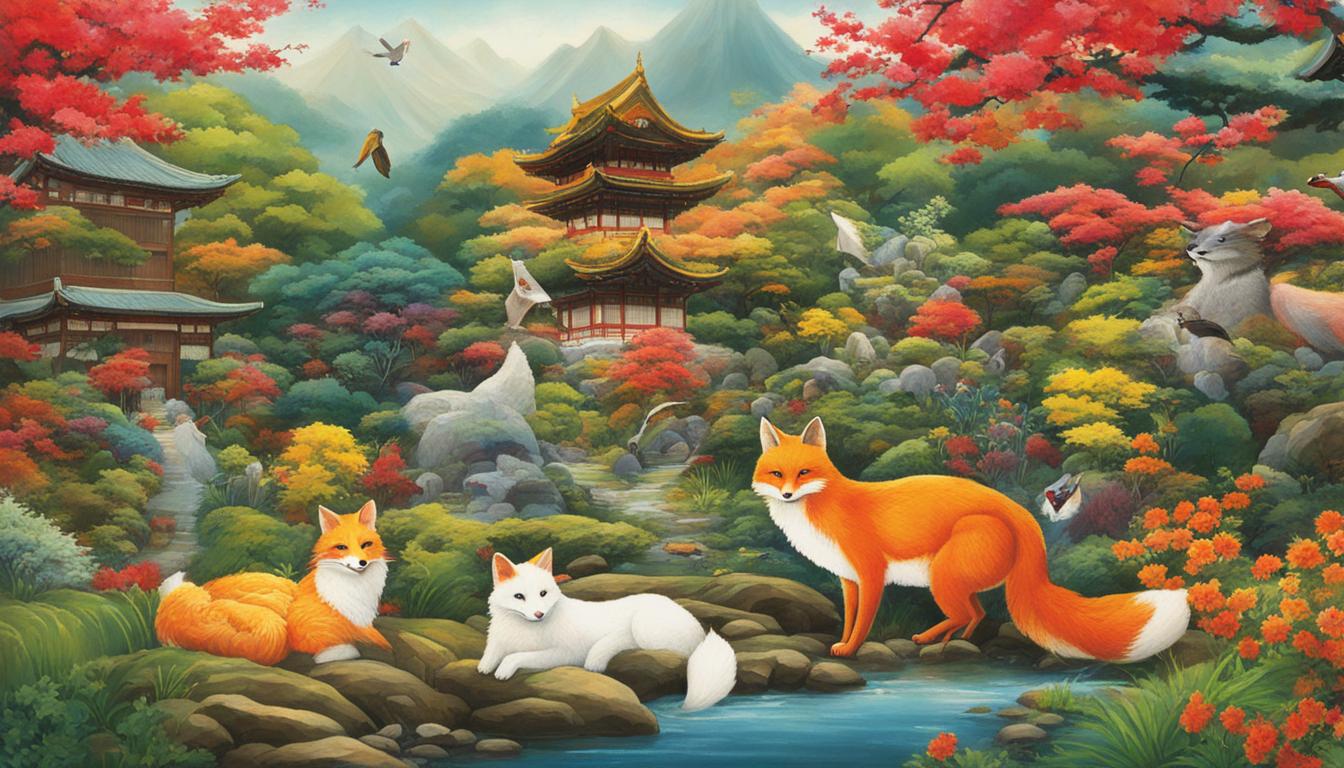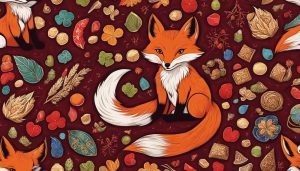In Japanese culture, there are animals that are believed to bring good luck and have deep cultural significance. These animals are rooted in Japanese folklore and mythology. Let’s explore the symbolic animals that are considered to bring good luck in Japanese culture.
Contents
Key Takeaways:
- Japanese culture believes in the good luck brought by certain animals.
- These animals are rooted in Japanese folklore and mythology.
- The symbolic animals are considered to bring good luck and have deep cultural significance.
- The animals include foxes, koi fish, cranes, and cats.
- Each animal has its own unique qualities and symbolism.
Fox (キツネ)
Foxes, known as “kitsune” in Japanese, hold a significant place in Japanese culture and are considered to be good luck charms. In Shintoism, they are believed to be messengers of the gods and are often depicted as guardians at Shinto shrines. Associated with Inari, the deity of rice production and business, foxes symbolize protection and prosperity.
In Japanese folklore, foxes are known for their sly and intelligent nature. They are believed to possess supernatural abilities and can shape-shift into humans, often seducing others with their charm. This dual nature of foxes represents both cunning and benevolence, making them powerful symbols of good fortune.
Japanese tradition encourages people to pay respect to foxes by leaving offerings or prayer charms at their shrines. It is believed that by doing this, one can receive blessings of luck, success, and wealth. Foxes are also associated with fertility and are often seen as guardians of domestic harmony.
The Symbolism of Foxes in Japanese Culture
The fox’s role as a messenger of the gods and its ability to bring good luck have made it an integral part of Japanese culture. It serves as a reminder of the importance of intelligence and resourcefulness in achieving success. The fox’s presence at Shinto shrines and its association with Inari highlights its significance in business and agriculture.
In Japanese folklore, the fox’s transformational abilities and its reputation for outsmarting humans have contributed to its status as a figure of admiration and respect. Its image is often portrayed in Japanese art and literature, reflecting the enduring charm and intrigue of this mystical creature.
Folklore and Popularity
Foxes are not only revered in folklore but also celebrated in modern Japanese culture. They appear in various forms of media, such as anime, manga, and video games. The popularity of the kitsune mask, a traditional Japanese mask representing a fox, has also spread beyond Japan and become recognizable worldwide.
The enduring fascination with foxes and their association with good luck continues to captivate people in Japan and beyond. Their timeless symbolism serves as a reminder of the rich cultural heritage and beliefs that shape Japanese society.
Lucky Animals in Japanese Culture: Koi (鯉)
In Japanese culture, certain animals are believed to bring good luck and are deeply ingrained in folklore and mythology. One such animal is the Koi fish, known as “鯉” in Japanese. These vibrant and graceful fish are considered to be symbols of good fortune, wealth, success, and longevity.
The Koi fish holds a special place in Japanese culture and is often found in decorative water gardens. Its mesmerizing colors and patterns make it a popular motif in traditional Japanese artwork and clothing. The Koi fish is even associated with the powerful Chinese dragons, further enhancing its auspicious symbolism.
Japanese folklore attributes positive qualities to the Koi fish, emphasizing its ability to overcome challenges and swim against currents. This resilience and determination are believed to inspire individuals to persevere and achieve their goals. The Koi fish is not only seen as a bringer of good luck but also represents strength and the triumph of the human spirit.

The Significance of Cranes in Japanese Culture
The cultural significance of cranes in Japan extends beyond their association with luck and blessings. Cranes are deeply rooted in Japanese mythology and folklore, often representing purity, wisdom, and the connection between heaven and earth. Their peaceful presence is believed to ward off evil spirits and bring good fortune to those around them.
It is worth mentioning that the graceful image of a crane in flight has become a symbol of peace and hope in global consciousness. The story of Sadako Sasaki, a young girl who folded a thousand paper cranes while battling leukemia after the atomic bombing of Hiroshima, has inspired people around the world to embrace the message of peace and healing that cranes embody.
| Symbolism | Meaning |
|---|---|
| Longevity | Believed to live for a thousand years, representing longevity and endurance |
| Good Fortune | Bringing blessings, prosperity, and happiness |
| Love and Devotion | Symbolizing a happy marriage and unity |
| Peace and Hope | Representing tranquility, purity, and global harmony |
The presence of cranes in Japanese culture is a testament to the reverence for nature and the profound symbolism associated with animals in Japanese folklore. Their significance goes beyond superstition and serves as a reminder of the connection between humans and the natural world, while inspiring hope and gratitude for the blessings that life brings.
Symbols of Good Luck in Japanese Culture: Cats (猫)

In Japanese culture, cats, or “neko” in Japanese, are considered to be symbolic animals that bring good luck and prosperity. The belief in the positive influence of cats can be traced back to ancient times, where they were revered for their mysterious and independent nature. Today, cats continue to hold a special place in Japanese society and are seen as objects of worship.
The most well-known representation of the lucky cat is the “Maneki-neko” or beckoning cat. This iconic talisman is often seen in businesses and homes, with its raised paw believed to bring good fortune and attract customers. The colors and accessories of the Maneki-neko also have symbolic meanings, with white representing purity and gold symbolizing wealth and prosperity.
Cats are also associated with protection against evil spirits and are believed to bring positive energy to their surroundings. They are commonly enshrined in shrines and temples throughout Japan, where people pray for good luck and blessings. The symbolism of cats as bringers of good luck is deeply ingrained in Japanese culture and continues to be celebrated and cherished.
Conclusion
Animals hold a special place in Japanese culture, serving as symbols of good luck and fortune. From the sly fox to the graceful crane and the mysterious cat, these creatures are deeply rooted in Japanese folklore and mythology. They play an integral role in the cultural fabric of Japan, whether portrayed in artwork, used as good luck charms, or believed to embody certain qualities.
The fascinating symbolism and cultural significance of these animals add an intriguing layer to the mystique of Japanese culture. Whether it’s the fox, known as “kitsune” in Japanese, associated with protection and prosperity, or the koi fish, revered as a symbol of wealth, success, and longevity, each animal brings its own unique meaning and blessings.
Cranes, with their graceful appearance, symbolize longevity and good fortune. They are believed to live for a thousand years and are seen as messengers of the gods. Cats, on the other hand, are considered lucky and prosperous in Japanese society. The “Maneki-neko” or beckoning cat is a popular talisman, believed to bring good fortune and customers to businesses, while also protecting against evil spirits.
By exploring and understanding the significance of these animals in Japanese culture, we gain a deeper appreciation for the rich folklore and traditions that shape the lives of the Japanese people. The animals that bring good luck in Japan are not just symbols, but an integral part of the cultural fabric that makes Japan a truly unique and enchanting country.
FAQ
What animals are considered to bring good luck in Japanese culture?
The animals considered to bring good luck in Japanese culture are foxes, koi fish, cranes, and cats.
What is the symbolism of foxes in Japanese culture?
Foxes, known as “kitsune” in Japanese, are believed to bring good luck and are considered a symbol of protection and prosperity. They are associated with the deity of rice production and business, Inari, and are often depicted as guardians at Shinto shrines.
What is the symbolism of koi fish in Japanese culture?
Koi fish are seen as symbols of good luck and perseverance in Japanese culture. They are believed to bring wealth, success, and longevity. Koi fish are often found in decorative water gardens and are a popular motif in traditional Japanese artwork and clothing.
What is the symbolism of cranes in Japanese culture?
Cranes are considered to be symbols of longevity and good fortune in Japanese culture. They are associated with happiness and prosperity, and are often depicted in Japanese wedding decorations. In folklore, cranes are believed to live for a thousand years and are seen as messengers of the gods.
What is the symbolism of cats in Japanese culture?
Cats are considered to bring good luck and prosperity in Japanese culture. They are often worshipped and enshrined in shrines and temples. The “Maneki-neko” or beckoning cat is a popular talisman believed to bring good fortune and customers to businesses. Cats are also associated with protection against evil spirits.






